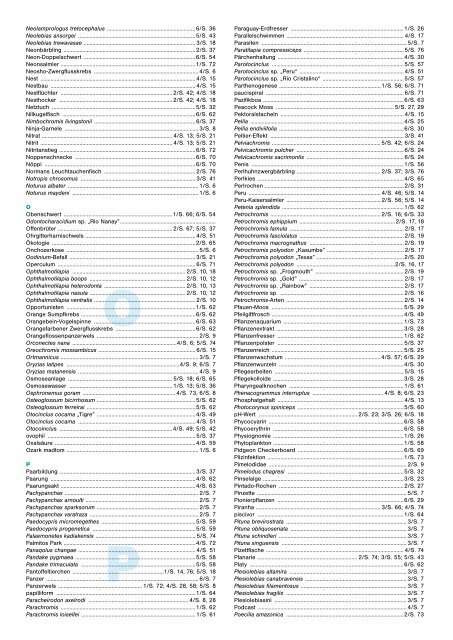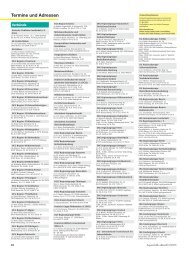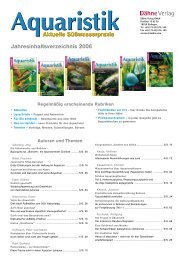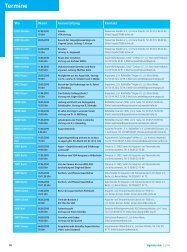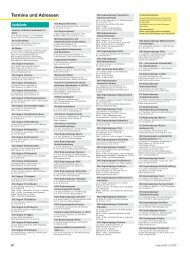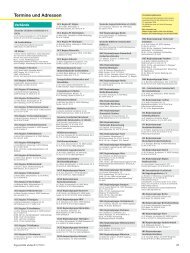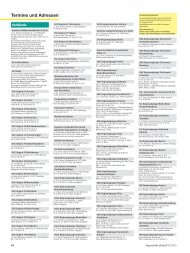Jahresinhaltsverzeichnis 2007 - Aquaristik aktuell
Jahresinhaltsverzeichnis 2007 - Aquaristik aktuell
Jahresinhaltsverzeichnis 2007 - Aquaristik aktuell
Sie wollen auch ein ePaper? Erhöhen Sie die Reichweite Ihrer Titel.
YUMPU macht aus Druck-PDFs automatisch weboptimierte ePaper, die Google liebt.
Neolamprologus tretocephalus .............................................................6/S. 36<br />
Neolebias ansorgei .................................................................................5/S. 43<br />
Neolebias trewavasae ............................................................................. 3/S. 18<br />
Neonbärbling ...........................................................................................2/S. 37<br />
Neon-Doppelschwert .............................................................................6/S. 54<br />
Neonsalmler .............................................................................................1/S. 72<br />
Neosho-Zwergflusskrebs ........................................................................ 4/S. 6<br />
Nest ........................................................................................................... 4/S. 15<br />
Nestbau .................................................................................................... 4/S. 15<br />
Nestflüchter ............................................................................. 2/S. 42; 4/S. 18<br />
Nesthocker .............................................................................. 2/S. 42; 4/S. 18<br />
Netztuch ...................................................................................................5/S. 32<br />
Nilkugelfisch ............................................................................................6/S. 62<br />
Nimbochromis livingstonii ......................................................................6/S. 37<br />
Ninja-Garnele ............................................................................................ 3/S. 8<br />
Nitrat .......................................................................................... 4/S. 13; 5/S. 21<br />
Nitrit ........................................................................................... 4/S. 13; 5/S. 21<br />
Nitritanstieg ..............................................................................................6/S. 72<br />
Noppenschnecke ...................................................................................6/S. 70<br />
Nöppi ........................................................................................................6/S. 70<br />
Normans Leuchtauchenfisch ...............................................................2/S. 76<br />
Notropis chrosomus ............................................................................... 3/S. 41<br />
Noturus albater .......................................................................................... 1/S. 6<br />
Noturus maydeni ....................................................................................... 1/S. 6<br />
O<br />
Obenschwert ...........................................................................1/S. 66; 6/S. 54<br />
Odontocharacidium sp. „Rio Nanay” ..................................................................<br />
Offenbrüter ............................................................................... 2/S. 67; 5/S. 37<br />
Ohrgitterharnischwels ............................................................................ 4/S. 51<br />
Ökologie ...................................................................................................2/S. 65<br />
Onchozerkose ........................................................................................... 5/S. 6<br />
Oodinium-Befall .......................................................................................3/S. 21<br />
Operculum ............................................................................................... 6/S. 71<br />
Ophthalmotilapia .............................................................................. 2/S. 10, 18<br />
Ophthalmotilapia boops .................................................................. 2/S. 10, 12<br />
Ophthalmotilapia heterodonta O........................................................ 2/S. 10, 13<br />
Ophthalmotilapia nasuta .................................................................. 2/S. 10, 12<br />
Ophthalmotilapia ventralis ...................................................................... 2/S. 10<br />
Opportunisten .........................................................................................1/S. 62<br />
Orange Sumpfkrebs ...............................................................................6/S. 62<br />
Orangebein-Vogelspinne ......................................................................6/S. 63<br />
Orangefarbener Zwergflusskrebs .......................................................6/S. 62<br />
Orangeflossenpanzerwels ...................................................................... 2/S. 9<br />
Orconectes nana ........................................................................4/S. 6; 5/S. 74<br />
Oreochromis mossambicus ................................................................... 6/S. 15<br />
Ortmannicus ............................................................................................... 3/S. 7<br />
Oryzias latipes ..............................................................................4/S. 9; 6/S. 7<br />
Oryzias matanensis ................................................................................... 4/S. 9<br />
Osmoseanlage ........................................................................ 5/S. 18; 6/S. 65<br />
Osmosewasser ....................................................................... 1/S. 13; 5/S. 36<br />
Osphronemus goram ................................................................ 4/S. 73, 6/S. 8<br />
Osteoglossum bicirrhosum ....................................................................5/S. 62<br />
Osteoglossum ferreirai ...........................................................................5/S. 62<br />
Otocinclus cocama „Tigre” ....................................................................4/S. 49<br />
Otocinclus cocama ................................................................................. 4/S. 51<br />
Otocoinclus ..............................................................................4/S. 49; 5/S. 42<br />
ovophil ......................................................................................................5/S. 37<br />
Oxalsäure .................................................................................................4/S. 59<br />
Ozark madtom ........................................................................................... 1/S. 6<br />
P<br />
Paarbildung ..............................................................................................3/S. 37<br />
Paarung ....................................................................................................4/S. 62<br />
Paarungsakt .............................................................................................4/S. 63<br />
Pachypanchax ............................................................................................ 2/S. 7<br />
Pachypanchax arnoulti .............................................................................. 2/S. 7<br />
Pachypanchax sparksorum ...................................................................... 2/S. 7<br />
Pachypanchax varatraza ........................................................................... 2/S. 7<br />
Paedocypris micromegethes .................................................................5/S. 59<br />
Paedocypris progenetica .......................................................................5/S. 59<br />
Palaemonetes kadiakensis ..................................................................... 5/S. 74<br />
Palmitos Park ...........................................................................................4/S.<br />
P<br />
72<br />
Panaqolus changae ................................................................................. 4/S. 51<br />
Pandake pygmaea ...................................................................................5/S. 58<br />
Pandake trimaculata ...............................................................................5/S. 58<br />
Pantoffeltierchen ...............................................................1/S. 14, 76; 5/S. 18<br />
Panzer ......................................................................................................... 6/S. 7<br />
Panzerwels .......................................................... 1/S. 72; 4/S. 28, 58; 5/S. 8<br />
papilliform ................................................................................................1/S. 64<br />
Paracheirodon axelrodi ..................................................................... 4/S. 8, 28<br />
Parachromis .............................................................................................1/S. 62<br />
Parachromis loisellei ...............................................................................1/S. 61<br />
Paraguay-Erdfresser ..............................................................................1/S. 26<br />
Parallelschwimmen ................................................................................. 4/S. 17<br />
Parasiten .................................................................................................... 5/S. 7<br />
Paratilapia compressiceps .....................................................................5/S. 76<br />
Pärchenhaltung .......................................................................................4/S. 30<br />
Parotocinclus ...........................................................................................5/S. 57<br />
Parotocinclus sp. „Peru“ ........................................................................ 4/S. 51<br />
Parotocinclus sp. „Rio Cristalino“ ........................................................5/S. 57<br />
Parthenogenese ...................................................................... 1/S. 56; 6/S. 71<br />
paucispiral ............................................................................................... 6/S. 71<br />
Pazifikboa .................................................................................................6/S. 63<br />
Peacock Moss ................................................................................. 5/S. 27, 29<br />
Pektoralstacheln ..................................................................................... 4/S. 15<br />
Pellia ..........................................................................................................4/S. 25<br />
Pellia endiviifolia ......................................................................................6/S. 30<br />
Peltier-Effekt ............................................................................................ 3/S. 41<br />
Pelviachromis ........................................................................... 5/S. 42; 6/S. 24<br />
Pelvicachromis pulcher ..........................................................................6/S. 24<br />
Pelvicachromis sacrimontis ...................................................................6/S. 24<br />
Penis .........................................................................................................1/S. 56<br />
Perlhuhnzwergbärbling .......................................................... 2/S. 37; 3/S. 76<br />
Perlkies .....................................................................................................4/S. 65<br />
Perlrochen ................................................................................................2/S. 31<br />
Peru ........................................................................................... 4/S. 46; 5/S. 14<br />
Peru-Kaisersalmler ................................................................. 2/S. 56; 5/S. 14<br />
Petenia splendida ....................................................................................1/S. 62<br />
Petrochromis ............................................................................ 2/S. 16; 6/S. 33<br />
Petrochromis ephippium ..................................................................2/S. 17, 18<br />
Petrochromis famula ............................................................................... 2/S. 17<br />
Petrochromis fasciolatus ........................................................................ 2/S. 19<br />
Petrochromis macrognathus ................................................................. 2/S. 19<br />
Petrochromis polyodon „Kasumbe” ..................................................... 2/S. 17<br />
Petrochromis polyodon „Texas” ............................................................2/S. 20<br />
Petrochromis polyodon ....................................................................2/S. 16, 17<br />
Petrochromis sp. „Frogmouth” ............................................................. 2/S. 19<br />
Petrochromis sp. „Gold” ........................................................................ 2/S. 17<br />
Petrochromis sp. „Rainbow” ................................................................. 2/S. 17<br />
Petrochromis sp. ..................................................................................... 2/S. 16<br />
Petrochromis-Arten ................................................................................. 2/S. 14<br />
Pfauen-Moos ...........................................................................................5/S. 29<br />
Pfeilgiftfrosch ...........................................................................................4/S. 49<br />
Pflanzenaquarium ...................................................................................1/S. 73<br />
Pflanzenextrakt ........................................................................................3/S. 28<br />
Pflanzenfresser .......................................................................................1/S. 62<br />
Pflanzenpolster .......................................................................................5/S. 37<br />
Pflanzenreich ...........................................................................................5/S. 25<br />
Pflanzenwachstum ..................................................................4/S. 57; 6/S. 29<br />
Pflanzenwurzeln ......................................................................................4/S. 30<br />
Pflegearbeiten ......................................................................................... 5/S. 15<br />
Pflegekolloide ..........................................................................................3/S. 28<br />
Pharyngealknochen ...............................................................................1/S. 61<br />
Phenacogrammus interruptus ................................................. 4/S. 8; 6/S. 23<br />
Phosphatgehalt ....................................................................................... 4/S. 13<br />
Photocorynus spiniceps .........................................................................5/S. 60<br />
pH-Wert .................................................................... 2/S. 23; 3/S. 26; 6/S. 18<br />
Phycocyarin .............................................................................................6/S. 58<br />
Phycoerythrin ..........................................................................................6/S. 58<br />
Physiognomie ..........................................................................................1/S. 26<br />
Phytoplankton ..........................................................................................1/S. 58<br />
Pidgeon Checkerboard .........................................................................6/S. 69<br />
Pilzinfektion ..............................................................................................1/S. 73<br />
Pimelodidae ............................................................................................... 2/S. 9<br />
Pimelodus chagresi ................................................................................5/S. 32<br />
Pinselalge .................................................................................................3/S. 23<br />
Pintado-Rochen ......................................................................................2/S. 27<br />
Pinzette ....................................................................................................... 5/S. 7<br />
Pionierpflanzen .......................................................................................6/S. 29<br />
Piranha ...................................................................................... 3/S. 66; 4/S. 74<br />
piscivor .....................................................................................................1/S. 64<br />
Pituna brevirostrata ................................................................................... 3/S. 7<br />
Pituna obliquoseriata ................................................................................ 3/S. 7<br />
Pituna schindleri ........................................................................................ 3/S. 7<br />
Pituna xinguensis ...................................................................................... 3/S. 7<br />
Pizettfische ............................................................................................... 4/S. 74<br />
Planarie ..................................................................... 2/S. 74; 3/S. 55; 5/S. 43<br />
Platy ..........................................................................................................6/S. 62<br />
Plesiolebias altamira ................................................................................. 3/S. 7<br />
Plesiolebias canabravensis ...................................................................... 3/S. 7<br />
Plesiolebias filamentosus ......................................................................... 3/S. 7<br />
Plesiolebias fragilis ................................................................................... 3/S. 7<br />
Plesiolebiasini ........................................................................................... 3/S. 7<br />
Podcast ....................................................................................................... 4/S. 7<br />
Poecilia amazonica .................................................................................2/S. 73


